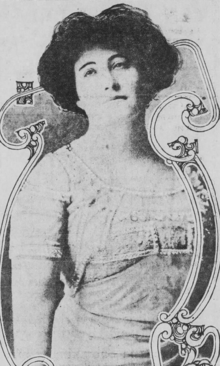Willa Holt Wakefield
Willa Holt Wakefield (November 9, 1870 – June 3, 1946) was an American vaudeville performer. Wakefield told stories and recited in the "pianologue" style, and was billed as "the Lady of Optimism".[1]
Early life and education[edit]
Willa Holt was born in Cuthbert, Georgia, the daughter of Peyton Robert Holt and Harriet (Hattie) Missouri Platt Holt. Her father was a pharmacist and a Confederate States Army veteran of the American Civil War. She studied piano with Theodor Leschetizky.[2]
Career[edit]
Wakefield taught school as a young woman.[3] She was a pianologue on the vaudeville stage in the 1910s and 1920s.[4][5] Her act featured sentimental, patriotic, humorous and nostalgic stories, recitations, and songs, presented with "elegance, refinement, self-control, and dignity".[6][7] "She is quite the pleasantest entertainer one could wish for," noted a Detroit critic in 1909.[8] In a 1917 interview, she explained her choice of material, saying "We very often move in a veritable mental mist in this sad old grumbling world, a thick mist of prejudice and irritability and hyper sensitiveness--and so we become more and more hypercritical ourselves. Yet, after all, it is a mist that can be easily dispelled by thrilling beams of mental sunshine."[1] Holt was promoted as a rival to the equally popular but more risqué entertainer Eva Tanguay.[4][6] She performed in England in 1913.[9]
Wakefield had a reputation for making shrewd investments,[10] and owned a farm on Long Island as well as a home on New York's Riverside Drive.[6] She also performed on radio programs.[11]
Personal life[edit]
Wakefield married Vienna-born sculptor Arnold Frederick Foerster in 1915; they divorced in 1936. She died in 1946, in Los Angeles, at the age of 75.[12]
References[edit]
- ^ a b "Willa Holt Wakefield is 'The Lady of Optimism'". The Pittsburgh Press. 1917-02-04. p. 47. Retrieved 2024-05-02.
- ^ "A Rose in Her Hair and a Song at Twilight". Star Tribune. 1914-05-17. p. 62. Retrieved 2024-05-03 – via Newspapers.com.
- ^ Glass, Dudley (1912-05-31). "How Forrest Adair Made a Star of a Plucky Young Schoolma'am". Atlanta Georgian. p. 7. Retrieved 2024-05-03 – via Newspapers.com.
- ^ a b "Miss Wakefield on Deck". New York Star. 2: 12. March 13, 1909.
- ^ Hickman, Walter D. (1925-03-20). "Putting Name of Willa Holt Wakefield in Our Very Own American Hall of Fame". The Indianapolis Times. p. 4. Retrieved 2024-05-03 – via Newspapers.com.
- ^ a b c Erdman, Andrew (2012-08-22). Queen of Vaudeville: The Story of Eva Tanguay. Cornell University Press. pp. 121–124. ISBN 978-0-8014-6572-7.
- ^ "The Art of Miss Wakefield". New York Star. 2: 25. November 14, 1908.
- ^ "Miss Wakefield Out West" New York Star 2(February 27, 1909): 23.
- ^ "About the Halls: With a Piano". The Sketch. 81: 128. January 29, 1913.
- ^ "Now Let Wall Street Beware for Willa is in 'the Game'". Chicago Tribune. 1909-10-17. p. 20. Retrieved 2024-05-03 – via Newspapers.com.
- ^ "Vaudeville Bill Has Varied Acts". The Montana Standard. 1929-04-07. p. 52. Retrieved 2024-05-03 – via Newspapers.com.
- ^ "Deaths Last Night". The Bee. 1946-06-04. p. 12. Retrieved 2024-05-03 – via Newspapers.com.

